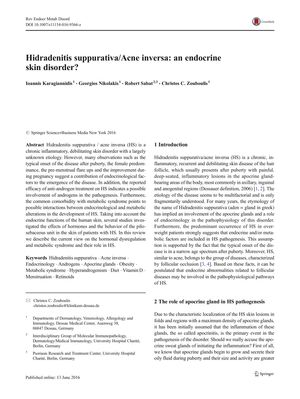TLDR Hidradenitis suppurativa may be related to hormones and patients often have metabolic disorders; more research is needed to understand this connection.
The document from 2016 examines the relationship between Hidradenitis suppurativa/acne inversa (HS), a chronic inflammatory skin disorder, and endocrine as well as metabolic factors. It notes the disease's tendency to manifest after puberty, its higher prevalence in females, and hormonal treatment responses, suggesting hormonal influences. Although studies show conflicting results regarding hormonal dysregulation, with some reporting higher androgen levels and others finding no significant differences, antiandrogen therapy has been effective for some patients. Additionally, a significant link between HS and metabolic syndrome is highlighted, with HS patients showing higher odds for conditions like central obesity and hyperglycemia. The document also discusses the role of adipokines and dietary factors in HS and reviews treatments such as metformin, dietary changes, retinoids, and vitamin D, with varying success. The conclusion emphasizes the need for further research to understand hormonal roles in HS and recommends metabolic disorder screening for HS patients before treatment.
 71 citations
,
January 2015 in “The Scientific World Journal”
71 citations
,
January 2015 in “The Scientific World Journal” Insulin resistance may contribute to various skin diseases and treating it could improve skin health and prevent more serious conditions.
 62 citations
,
March 2013 in “JAMA Dermatology”
62 citations
,
March 2013 in “JAMA Dermatology” Finasteride reduces Hidradenitis Suppurativa flare-ups in children and teens, but long-term safety is unknown.
75 citations
,
September 2009 in “Dermato-endocrinology” The skin produces and processes hormones, affecting both local and overall body functions.
 99 citations
,
April 2005 in “Journal of Dermatological Treatment”
99 citations
,
April 2005 in “Journal of Dermatological Treatment” Finasteride effectively treats hidradenitis suppurativa for most patients.
 146 citations
,
January 2004 in “Hormones”
146 citations
,
January 2004 in “Hormones” Human skin acts like a hormone-producing organ, making and managing various hormones important for skin and hair health.
289 citations
,
May 2003 in “Journal of Investigative Dermatology” Human skin can produce steroids from cholesterol.
 70 citations
,
January 2000 in “Hormone Research in Paediatrics”
70 citations
,
January 2000 in “Hormone Research in Paediatrics” SAHA syndrome is a condition in women involving skin and hair issues, often related to hormonal imbalances, and is treated based on the underlying cause.
 50 citations
,
December 1999 in “British Journal of Dermatology”
50 citations
,
December 1999 in “British Journal of Dermatology” Finasteride improves hidradenitis suppurativa but not for child-bearing women.
2 citations
,
August 1999 in “PubMed” 198 citations
,
January 1998 in “Dermatology” The human sebocyte culture model has improved understanding of oily skin and acne, and how they can be treated.
 8 citations
,
August 2020 in “Clinical and Experimental Dermatology”
8 citations
,
August 2020 in “Clinical and Experimental Dermatology” Spironolactone is a low-cost, effective, and generally safe treatment for various skin conditions related to hormones.
 18 citations
,
September 2017 in “Clinics in Dermatology”
18 citations
,
September 2017 in “Clinics in Dermatology” Obesity is linked to various skin disorders, which can help with early diagnosis and prevention of long-term health issues.
 41 citations
,
June 2016 in “Reviews in endocrine and metabolic disorders”
41 citations
,
June 2016 in “Reviews in endocrine and metabolic disorders” Hidradenitis suppurativa may be related to hormones and patients often have metabolic disorders; more research is needed to understand this connection.









